I baked my Network Controller. I was skeptical, but whaddaya know? It DOES work!
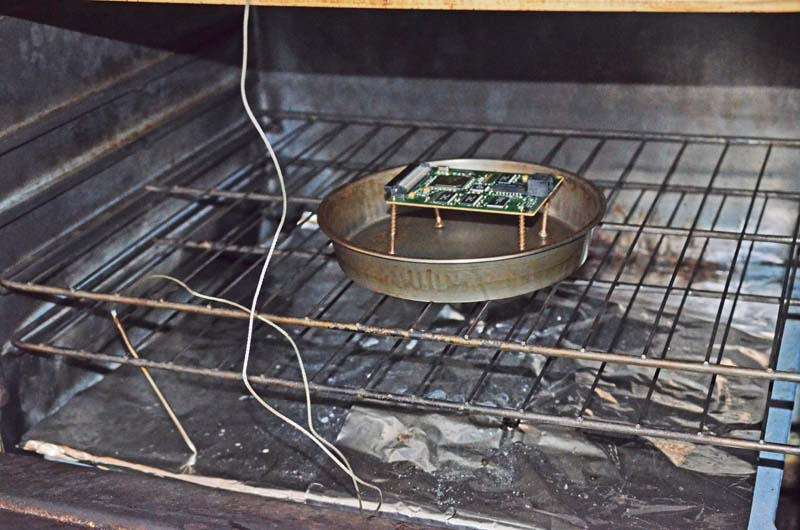
So, my trusty old HP Laserjet 2200 network printer went on strike Sunday morning. I’ve had it for a decade, even bought a refurbished carcass a few years back to dodge the job of configuring new printer settings on all of my computers. Stuck in the same old JetDirect card and kept on as though nothing happened – until last week. I had to power cycle it several days ago to get it back up and running. Sunday morning it was off-line again even though the LAN port LED’s were lit up. I power cycled again, and this time I pulled out and re-inserted the card. Configuration page told me the EIO slot was empty. I was pretty sure it was the end of the line for my faithful old printer. Good thing I hadn’t spent money on a new toner cartridge. Before giving up entirely, I decided to check if the fine bots at Google could connect me to someone smarter than I am.
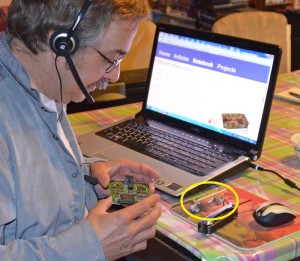
Step 2
I thought it had to be a prank when I first read the magic cure here. Bake the card? Yeah, right. Even this long page of testimonials left me wondering just how elaborate this hoax was. But finding it again here on the HP site, and here, and finally in an image search here convinced me to try it.
RECIPE
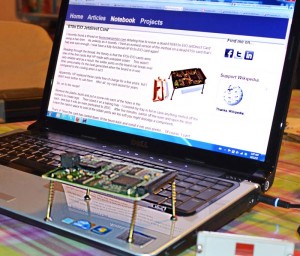
Step 3
- preheat oven to 200° (400°F)
- remove plastic bezel from Jet Direct card
- put #8 x 2” screws into the holes in 4 corners to act as legs
- set the card in a baking pan
- place into preheated oven and bake for 5 minutes at 200°
- Turn oven off & open door
- Allow card to cool before handling or removing from oven
- Reattach Bezel and plug back into printer
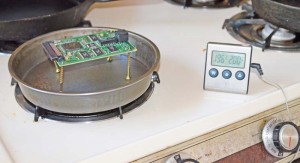
Step 4
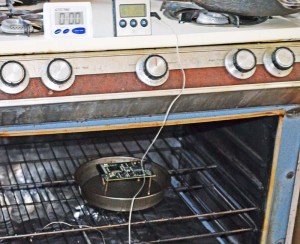
Step 7
Apparently the heat re-flows the solder in any cracked chip connections, and the card is good for years again (or until another solder connection fails from the chip heating and cooling in use.) An alternate method described is to use a hi-temp hair dryer on the card, but many report that fix is only temporary – probably because hair dryers do not produce enough heat to properly melt solder. Others have reported that a heat gun (paint stripper) will do a better job. I don’t have one, so it’s the oven method for me. Here goes nothing-to-lose.
(later) Well, whaddaya know? It’s alive! Network printing is fully functional again. Another 10 years? Better order toner after all.


It’s alive!!! Thank you so much!
It totally effing worked, Mr. Jim! This must be how Dr. Frankenstein felt.
As you instruct, it’s important to: (a) bake chips up and (b) don’t bump until it cools.
My symptom on an HP 4550 (workhorse of a battleship of a boat-anchor of a big 1990’s era color laserjet) was the screen showed two rows of asterisks ************** when the JetDirect card was installed. Baking the JetDirect card J1469a 5 minutes at 400F (200C) brought the little monster back from the dead.
THANK YOU! Very timely post.
Correction, J4169A, JetDirect 610n Print Server by (for, of) HP.
I had no idea you were so into cooking, Jim. Thanks for sharing this amazing find. I have an HP printer and when it needs baking, I now know what chef to call on 🙂
It is amazing how we look for hi tech answers for so many things when the simplest ones will do. Now I wonder … do they bake these connections in an enamel oven in the first place? Wondering how things are made and how they work is a fascination of mine. Years ago, when I asked my cousin who was using punch cards on the “big computer” in Colorado, what happened with each hole as it went through the “machine” … she said she did not know and she did not have to know. I knew then that I would have some difficult times with the new technologies. My curiosity had always compelled me to learn as much as was possible about all parts and connections … I had even dismantled a 1945 Willys jeep engine compartment and put it back together so I could find out how and why it worked. No parts left over either when I got it back together! Of course, I was not old enough to drive it yet, so all that understanding had to wait a bit.
And so, baking the board does make sense … thanks for giving me a trip down memory lane, plus a new recipe!